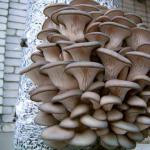Households in a number of European countries actively use eurofirewood (fuel briquettes or pellets) as fuel for heating. The leader in the development of technologies is Austria, where, so far, in the balance of consumption, gas is significantly inferior to other types of fuel.
In addition to households, eurofirewood is used by utilities, construction companies such as bitumen plants and agricultural enterprises, including poultry farms, canneries, etc.
For the production of eurofirewood, technologies are used, which are based on two technological processes, grinding waste to a standard size and their subsequent pressing under high pressure by extrusion. In finished form, eurofirewood is formed bars of a cylindrical or polygonal shape. Briquette length - 20-30 cm, diameter - from 10 cm. Briquettes are sold in packs of 12 pieces, transported on pallets of 96 packs. The weight of one pallet is about a ton. The heat transfer of eurofirewood during combustion is comparable to coal, and the ash content and environmental damage are much lower.
|
|
Production area.
The production of eurofirewood is environmentally friendly, therefore it does not require special permits. The required production area depends on the selected production volume and equipment. For the production of 150 kg. eurofirewood per hour production can be placed on an area from 100 to 150 meters and 50-100 meters will be required for an open storage area for raw materials and finished products.
Placement of equipment for the production of 1000 kg of euro firewood per hour will require 300 meters, and a warehouse of at least 300 meters. Three-phase electricity connection 380 W, power consumption up to 50 kW.
Staff.
With a 3-shift operation of the enterprise, the number of employees will be 14 people. The director and the storekeeper-accountant work on a 5-day schedule, and the workers work 4 people in three shifts.
Used raw materials for production
For the production of eurofirewood, waste wood from the processing industry, such as shavings, sawdust, wood chips, straw and sunflower seed husks are also used. The largest volume of business waste is generated in the furniture, woodworking and logging industries: shavings, chips, sawdust, foliage, slabs, wane, lumpy waste, pulpwood and trunks of various tree species, etc.
Technology and equipment for the production of eurofirewood.
For pressing or extruding, the size of the fraction should not exceed 3 mm, the humidity should not exceed 15%. Most sawdust and wood chips have a larger fraction and high humidity. Therefore, the raw material is initially crushed and dried.
1. Chipper.
For grinding large waste, chippers are used, in which the raw material enters the receiving window, is captured by toothed rollers and enters the grinding zone. In the grinding zone, the knives of the rotating drum separate the chips and feed them to the grate. That part of the chips that did not pass the calibration is returned for re-grinding. At the outlet, the chips have a size of 10-35mm.
2.Heat generator.
Drying is done with air. There is equipment that also grinds wood chips during drying. Hot air is provided by a heat generator, fueled by eurofirewood of our own production.
3. Extruder.
Further, the mass prepared to the technological standard is sent for pressing. The raw material is squeezed out through a die under high pressure and cut into measured briquettes 20-35 cm long, then it goes to the finished product warehouse. Eurowood should be stored under a canopy or in sealed packaging.
Markets for Eurowood.
The main part of eurofirewood produced in Russia is exported to European countries, but, for some time now, the growth of tariffs and permits for connecting to gas supply has begun to create domestic demand, which by 2020 may double.
For advertising and marketing of products, it is advisable to have your own online store, place products in large retail chains and supermarkets. For export, it is worth contacting enterprises with an export-oriented business, with warehouses and a distribution network in Europe.
Investments and calculation of efficiency.
The cost of a set of equipment for the production of 1000 kg. eurowood per hour is about 9,000,000 rubles. Equipment of this capacity is produced in China and South Korea. It is advisable to use a complex with a smaller capacity in cases where there is own raw material in the immediate vicinity of the production. In the latter case, the cost of equipment may not exceed 500,000 rubles.
For an enterprise with equipment with a capacity of 1000 kg. eurowood per hour, the daily output, taking into account the time for repair and adjustment, will be 20 tons. With the cost of eurofirewood 4,000 rubles a ton, the monthly sales volume will be 2,400,000 rubles.
Monthly expenses will be:
Raw materials - 180,000 rubles:
Salary 20% of sales including taxes - 480,000 rubles:
Electricity - 350,000 rubles:
Transportation costs 7% of sales: - 168,000 rubles:
Other overhead costs 9% of sales: - 216,000 rubles.
Total costs - 1,394,000 rubles:
Profit before tax (gross) - 1,006,000 rubles:
It is advisable to use the organizational and legal form of an individual entrepreneur. Tax for PP under the simplified tax system 15% - 151,000 rubles:
Net profit - 855,000 rubles:
Payback period-10. 5 months.
Of great importance for this business will be the state of the global market for hydrocarbons and the sanctions regime. If European consumers reduce their consumption of Russian gas, then there may be an excess of it on the domestic market and, accordingly, a fall in prices, including for alternative sources of energy supply.
| Back | Forward -Production of bearings: how to start this business? |
|
|
Eurowood production is a new and very profitable type of entrepreneurial activity.
Due to the presence of a hole inside the briquette, eurofirewood burns without emitting smoke. The problem of the release of volatile substances and unpleasant odors is also excluded.
This type of fuel is ideal in terms of fire safety for open fireplaces, since it does not spark when burned. The ash can be used as fertilizer in the garden.
Eurofirewood is produced from woodworking industry waste (branches, shavings, sawdust, straw). For many manufacturers of furniture and lumber, waste disposal is a serious problem that requires additional costs. It may well be that you do not even have to pay for raw materials - it will be enough to regularly take them out on your own transport.
The production of eurofirewood from sawdust and other waste consists of several stages:
- Crushing of raw materials.
- Drying.
- Pressing into briquettes of the desired shape.
- Drying of finished products.
The type of wood does not play a special role in the briquetting process.
But, in order to achieve maximum machine productivity and high product quality that will suit demanding European customers, several rules should be observed:
- Do not mix shavings and sawdust.
- The fraction of raw materials should not exceed 3 mm.
- It is advisable to use wood of the same species.
- Maximum performance is achieved with hardwood.
How is cheese made and what is needed for this? Get to know what is interesting, find out the strengths of this business.
The market for waste disposal equipment is replenishing quite quickly today. Learn how plastic bottles are recycled into fuel.
Eurowood productionEquipment for the production of eurofirewood can be assembled by purchasing separate units. Manufacturers also offer ready-made lines.
The line for the production of eurofirewood in industrial volumes for sale to wholesale buyers consists of the following units:
- chipping machine;
- hammer crusher;
- sawing device;
- line for moving raw materials;
- pneumatic conveyor;
- bucket loader;
- preliminary grinder;
- vibrating sieve;
- storage hopper;
- screw press for making briquettes (briquette);
- heat generator;
- dryer drum;
- cooling line for finished briquettes;
- finished product packer.
 An automated line for the production of eurofirewood will save on wages for workers.
An automated line for the production of eurofirewood will save on wages for workers.
For maintenance of equipment with a capacity of up to 250kg / h, 2-3 workers are enough.
The productivity of a complete automated equipment cycle is much higher.
The production of eurofirewood in small volumes can be organized in a small room.
To sell products to private buyers on a local scale, you can limit yourself to a minimum set of equipment:
- crusher;
- machine for the production of eurowood;
- dryer.
Most of the operations will have to be carried out manually, the productivity of such a workshop will be minimal. But, for a private mini-enterprise as a start, this option is quite suitable.
Room equipmentCertain requirements are put forward for the production premises from the sanitary services and the fire inspection. The required voltage in the mains is 380 V.
Necessarily equipped with sewerage and water supply. Also, you should take care of the ventilation of the room.
The area of the production premises depends on the capacity and set of equipment. There are strict safety standards that allow you to calculate the required area.
How to organize the production of double-glazed windows? What equipment is needed for this business? In the material, look and find out the important points of this business.
What is the secret of the demand for dumplings among the population? Tasty and healthy food will always be fashionable. You will learn how the dumpling machine works.
The confectionery business has every chance of success if all technological requirements are met. From the material you can find out how the production of mini bakeries for pastry shops is organized.
 On the market, you can purchase domestic and foreign equipment for the production of eurofirewood.
On the market, you can purchase domestic and foreign equipment for the production of eurofirewood.
There are proposals for both new machines and used equipment. Domestic manufacturers offer reliable and high performance options.
The purchase of domestic equipment is also more profitable in terms of commissioning, after-sales service, and the search for components.
A good reputation among manufacturers from the company "Bikpress".
Reinforced roller press PVU - 1500 from the manufacturer "Bikpress" works with raw material screenings of charcoal, coal and other various small fractions using adhesives.
Main technical data:
- power consumption - 2-3 kW / h;
- productivity - up to 1500 kg / h;
- height - 1300 mm;
- width - 600 mm;
- length - 1600 mm;
- weight - up to 500 kg.
Other types of equipment and components can be purchased from this manufacturer.
Compared to domestic counterparts, Chinese equipment is cheaper. But, you should take into account the cost of transportation and possible problems in the delivery process.
It is not a fact that you can count on service and reliability of this equipment.
If you have the opportunity to conclude an agreement that takes into account all possible risks, the purchase of Chinese equipment will save on start-up investments.
An excellent reputation with the Danish equipment manufacturer C.F.Nielsen.
An example is a shock-mechanical press for the production of eurofirewood BP 6500HD.
Main technical data:
- productivity - up to 1400 kg / h;
- briquette length - 75 mm, width - 65x65 mm;
- engine power - 45/55 kW;
- weight - 5500 kg;
- centralized lubrication system - slide / bearings;
- overall dimensions - 1700x1550x2850 mm.
 This equipment makes it possible to produce eurofirewood of the highest class.
This equipment makes it possible to produce eurofirewood of the highest class.
The company offers customers separate units and automated lines for the production of eurofirewood.
Service centers work with customers at a very high level, carry out commissioning, repair and uninterrupted supply of components and spare parts.
Video about the production of eurofirewoodIt cannot be denied that sawdust briquettes are one of the most efficient solid fuels used for home heating. They are high-calorie (heat output is about 5 kW from 1 kg when burned), have a low ash content, and are also convenient in storage, since they take up little space. But you can’t exactly call this fuel cheap, far from everyone can afford to heat a boiler or stove with eurowood throughout the season.
This is where the interest of many homeowners arises - is it possible to somehow make fuel briquettes with your own hands? Especially when there is raw material for this at a meager price. The solution to this issue is precisely the topic of this article. It will consider various technologies for the production of briquettes from sawdust and other types of raw materials in production and at home. As a result, it will become clear under what circumstances it makes sense to take on this matter.
Methods for making briquettesTo get an idea of how you can make fuel briquettes with your own hands, you must first study how they are produced in the factory. The preparatory stage for any technology is the same and consists in grinding and drying raw materials. These are, of course, sawdust and larger woodworking waste, which are processed to make briquettes. Then the raw material is subjected to drying in order to bring its moisture content to no more than 8-10%.
For reference. Also, various agro-industrial wastes (husks, husks of seeds) and even coal dust can serve as the starting material for the production of eurofirewood.

I must say that with both technologies, the result is achieved due to the strong compression of wood raw materials, as a result of which a natural component, lignin, begins to be released from it. It also serves as a binder for this crumbly mass, no others are provided. The difference is only in the method of squeezing, in the first case a hydraulic briquette press is used, developing a force of 300-600 bar.
From such compression, the raw material spontaneously heats up, which only contributes to the formation of a strong rectangular “brick”. How the briquetting line with a hydraulic press functions is shown in the video:
 This is how eurofirewood is squeezed out with a screw press
This is how eurofirewood is squeezed out with a screw press The extrusion method for the production of sawdust briquettes is easy to understand using the example of a conventional home meat grinder or juicer. The raw material is loaded into the receiving hopper of the unit and moved by the auger into the tapered working channel of the conical shape. There it is compressed, while the screw press for briquettes develops a monstrous force - up to 1000 bar.
At the output, firewood is obtained from sawdust in the form of a hexagon, which undergoes additional heat treatment and is cut into one size with a special knife. The device of the screw press for sawdust in the section is shown in the drawing:
 The main load falls on the auger (pos. 5) and the conical sleeve (pos. 7), the wear of parts directly depends on the number of extruded briquettes. Production at home
The main load falls on the auger (pos. 5) and the conical sleeve (pos. 7), the wear of parts directly depends on the number of extruded briquettes. Production at home It is clear that acquiring such powerful equipment to press briquettes at home is an empty undertaking. Even if you have funds and gratuitous raw materials, you will be able to recoup its cost only if you press firewood from sawdust for sale. This means that it will not be possible to withstand the traditional technology with the release of lignin.
Instead, home craftsmen adapted to use different binders to form "bricks", for example:
- wallpaper or other cheapest glue;
- clay;
- paper, corrugated board.
In order not to buy expensive drying and pressing equipment, fuel briquettes are made at home as follows. Sawdust is soaked in water and thoroughly mixed with clay in a ratio of 1: 10, or soaked cardboard or wallpaper paste is added. The resulting mixture for making a briquette is placed in the form of a home-made manual sawdust press and squeezed by hand. Then the "brick" is removed from the mold and laid to dry naturally, on the street.
For reference. Using this technology, smart owners press briquettes from any available materials that can burn: from straw, paper, cardboard, leaves, seed husks, and so on.
Equipment for the production of The simplest do-it-yourself press for making fuel briquettes has a manual screw drive. The molding container with perforation is filled with the mixture and placed under the frame, the pressure is created by tightening the screw. The design is very simple and it makes no sense to talk about it in detail, just look at the picture.
The simplest do-it-yourself press for making fuel briquettes has a manual screw drive. The molding container with perforation is filled with the mixture and placed under the frame, the pressure is created by tightening the screw. The design is very simple and it makes no sense to talk about it in detail, just look at the picture.
Such screw machines for pressing sawdust briquettes are not very popular due to low productivity. Too much time is spent loading the container, tightening the screw and removing the finished product. It is much faster and easier to squeeze out "bricks" on a home-made press with a long lever and a mechanism for pushing the briquettes out. To speed up the process, 2 molds can be welded to the frame instead of one.
 Manual machine for 2 forms with a pipe lever
Manual machine for 2 forms with a pipe lever Some craftsmen can boast of more advanced mechanized equipment. Indeed, a manual machine can be improved and the performance of a briquette can be improved by installing a hydraulic jack instead of a manual drive. To assemble such a unit, you will have to tinker a lot, but the result will be much better.
 Manual machine with hydraulic jack
Manual machine with hydraulic jack Note. Even using a hydraulic jack in a homemade press, it will still not be possible to create a pressure of at least 300 bar. Therefore, it will still not be possible to reproduce the factory technology without adding water and binders.

Despite the great difficulties with the manufacture of parts, some of the craftsmen managed to assemble a screw press and get briquettes of fairly decent quality. This is evidenced by the reviews of such people on the forums. But they all point out the high costs of manufacturing screw parts and housing from high quality steel. Again, an electric drive is indispensable here, with the most conservative calculation, an engine with a power of at least 7 kW is required.
Homemade briquettes - pros and cons
The reasons why this type of fuel is very attractive are understandable. When a person has his own wood production or the ability to buy cheap sawdust for a briquette, then thoughts about making them at home are quite natural. The fact is that not all heating equipment is suitable for burning sawdust. As a rule, wood chips in an ordinary stove or boiler burn out quickly and give off little heat, and even half will spill into the ash pan.
To successfully burn wood waste, you need a special mine-type boiler or. It is quite difficult to make this, the prospect of pressing sawdust into fuel briquettes seems much more rosy.
It turns out that everything is not so simple here either, and here's why:
 After squeezing out the water and subsequent drying, the briquette becomes quite light.
After squeezing out the water and subsequent drying, the briquette becomes quite light. The second point requires clarification. Due to the inability to comply with the technology, “bricks” after drying are light due to their low density. Their specific heat of combustion is three times lower than that of wood, which means that they will need three times more for heating. The whole process will take a lot of time and take a lot of energy. And it is very difficult to store such a volume of fuel so that it does not accumulate moisture.
Informative video for enthusiasts who want to put pressure on manual briquetting of various household waste:
Conclusion
It is, in principle, possible to make fuel briquettes with your own hands on home-made equipment. But for this you need to have enough free time and a place for drying and storing fuel. It is also important that sawdust does not have to be transported from afar or expensive to buy. In this scenario, the event generally loses all meaning, it’s better to buy a truckload of firewood. The choice is yours, dear homeowners.
Fuel briquettes, or eurofirewood, are today one of the alternative types of solid fuel. The raw material from which they are made is an affordable, natural and environmentally friendly material. The production of sawdust briquettes intended for heating boilers, fireplaces and stoves can be organized at home.
Make fuel briquettes from sawdust with your own hands
Description, composition and featuresLogs of compressed wood particles are called sawdust briquettes. They come in various shapes, but this feature does not affect their calorific value. The combustion mode of briquettes is the same as that of coal or firewood: the fuel heats up, decomposes into pyrolysis gases, mixes with oxygen and ignites.
For the production of fuel briquettes from sawdust, wood (sawdust, shavings, dust) is most often used, but straw, paper, peat, seed and nut husks may well be used.
In this video, consider the mixture for briquettes:
Briquette fuel has a number of advantages:
- in comparison with firewood, it has an increased heat transfer, second only to coal;
- due to low humidity provides a high combustion temperature;
- forms a small amount of ash;
- burns with an even flame without sparks and cod;
- gives a minimum emission of carbon dioxide;
- there is no soot during combustion;
- the process of burning one bookmark of fuel takes longer (compared to firewood);
- does not contain harmful elements for health.
 Save money with alternative fuel sources
Save money with alternative fuel sources
Eurowood also has some disadvantages. Firstly, they are afraid of moisture, so they require dry warehouses and woodsheds for storage. Secondly, they cannot be subjected to strong mechanical stress. Thirdly, with the manufacture of fuel briquettes at home, difficulties may arise due to the purchase of equipment that is expensive, but if it is available and with access to free sawdust, it will be possible to establish production even in the garage.
In addition to the fact that briquettes can heat stoves, fireplaces and baths, it is very convenient to take them outdoors for barbecue and barbecue, and the absence of smoke during combustion makes it possible to use them even indoors.
Briquette manufacturing technologyThe raw material for the production of fuel briquettes is woodworking waste - sawdust, the main supplier of which is the sawmill. The types of wood do not matter, but the moisture content of the raw material should be no more than 12%, the size should be up to 6 mm. Decayed wood should not be more than 5% of the total mass of waste. First, sawdust is sorted to exclude large pieces of wood, after which they are fed into a crusher, and then for regrinding, where they are given the desired size.
Crushed sawdust is fed into the heat generator and mixed with flue gases, then - to the dryer drum. From there, the briquette mass enters the cyclone, in which dry waste is separated from gases and settles to the bottom. Next, the material enters the conveyor and presses or extruders to create the necessary pressure. Sawdust briquettes for the firebox are made in two ways:
- creation using a hydraulic press;
- extrusion method.
The extrusion method consists in the fact that the raw material is poured into the receiving hopper of the device and passes into a narrowing working channel, where it is strongly compressed with a press. The result is firewood from sawdust in the form of a hexagon. After heat treatment, they are cut to the same size with a special knife.
With both technologies, the production of eurofirewood proceeds by strongly squeezing wood waste, as a result of which lignin, a binder, is released from them. From strong compression, the raw material is heated, as a result of which rectangular logs are formed. The briquette heats up so much due to the high pressure that it chars a little. In some cases, after the press, the blanks are sent to a furnace for even more heat treatment.
Hydraulic and screw presses contribute to the release of lignin, but the maintenance of such units is expensive, so they are used only in industrial production.
DIY fuelIt would be unrealistic to think that anyone would undertake to buy such a powerful unit for home use. It will not be possible to apply the technique for obtaining lignin at home. But some masters have learned to use other binding materials. In order to start making your own wood from sawdust with your own hands, you should consider the following:
Thus, having thought about how much effort, time and finances it will take to produce briquette fuel at home, many will prefer ordinary firewood or coal. To start making sawdust briquettes with your own hands, it is not necessary to buy expensive equipment. Home craftsmen came up with the idea of preparing briquettes for heating from various combustible materials: paper, straw, cardboard, leaves, etc.
To make eurofirewood with your own hands, you need to lower the sawdust into water, put clay there in a ratio of 1:10, stir, add wallpaper paste or soaked cardboard. This mixture should be poured into the mold and squeezed as tightly as possible with your hands. Then the figures are removed from the mold and laid out in the sun to dry.
For quick briquetting, each figure can be overlaid with paper or rags. As for homemade pressing machines, they are usually made in three versions:
- with manual drive;
- with jacks;
- with hydraulic drive.
One of the simplest options for the machine: a frame is welded from a metal pipe, which can be attached to the wall of the house. A rectangular shape is attached to the lower part of the frame, on top - a lever that goes inside it. The second and third option is that the briquette press is represented by a jack or a hydraulic drive, which are designed in place of the lever.
Is the wood burning business relevant in 2019? Despite the spread of gas or electric heating, the demand for this product is stable. Firewood is used for stove heating in rural areas, for wood-burning boilers, baths, fireplaces, greenhouses. An additional advantage is the high profitability of this business. We tell you how they make money selling chopped firewood, where to start such a business, as well as how and from what eurofirewood is produced and how much money you have to spend to open your own business.
Of course, wood heating is much inferior in popularity to gas and electric. However, the demand for it remains high due to several areas where there is virtually no substitute for firewood. In many regions of Russia, especially in rural areas, there are no other heating options other than stove. Firewood is in demand by the owners of bathhouses, houses with fireplaces and greenhouses. Therefore, the opportunity to make money on their sale is quite real even in 2019. Firewood prices can be very high, which is an additional benefit for the business.
The complexity of the business is associated with high competition. Each region has several suppliers that generally cover the needs of the market. It should not be forgotten that some citizens prefer to harvest their own firewood or buy waste from local sawmills, especially if they need a little fuel. This can be a serious obstacle for a novice businessman. Therefore, for successful earnings, you will have to attend not only to the supply channels of raw materials, but also to sales, and even marketing.
Even in 2019, wood remains an important and sometimes indispensable heating option.
How to start a firewood businessSelling firewood can be a lucrative business in any region of Russia, but it takes hard work to successfully enter the market. It is worth starting preparations for launching your business by studying the state of the industry in your city and region: how many firewood suppliers are already working, who will be potential customers. At this stage, you need to determine your specialization - chopped firewood or fuel briquettes, as well as competitive advantages, for example, sell firewood with delivery.
Next, you need to prepare a business plan (see the next section) and determine the amount of investment required. If an entrepreneur will only sell firewood, it is enough for him to conclude an agreement with the forestry and find a place to store wood. If you plan to produce euro briquettes, you will need special equipment and a workshop, and the opening process will take a little longer.
A good solution would be to think about marketing in advance, determine the target audience and find ways to inform buyers about yourself. Some manufacturers confine themselves to ordinary paper advertisements, while others resort to the help of radio and television. In this area, reputation is of great importance: if the firewood of an entrepreneur suits one buyer in terms of price and quality, he will advise them to neighbors and acquaintances. The effect of "word of mouth" will work, which will bring more new customers. This rule also works vice versa. If someone received wet firewood or products with other defects, an outflow of buyers should be expected.
Business plan for the sale of chopped firewoodFirewood harvesting as a business should not break the law. Before chopping wood and selling firewood, an entrepreneur must obtain a logging permit - a logging ticket. To do this, you need to contact the regional authority that controls the forestry sector. This may be a department or the ministry of forestry, in different subjects of the federation the names are different. Another option is a multifunctional center where you can also get this public service. Prepare a package of documents:
- statement;
- passport;
- terrain plan;
- description of green spaces.
The issuance of permits in each region is regulated by a special legislative act, the cost of the forest will also be indicated there. Cutting trees without state permission is strictly prohibited. This is classified as poaching and is punishable by law.
A sample business plan for selling firewood:
- Registration of a business, individual entrepreneur or LLC, 800 or 4 thousand rubles.
- Obtaining a logging ticket, payment for logging, from 10 thousand rubles.
- Purchase of equipment and transport. From 100 thousand rubles.
- Renting, buying or building a firewood storage room. From 20 thousand rubles.
- Hiring employees: lumberjacks and drivers. Formation of the wage fund.
- Search for distribution channels, advertising, distribution of announcements. Possibly without investment.

Logging and firewood harvesting is allowed only with state permission
The split firewood business is seasonal. Most firewood is bought at the end of summer and autumn - with an eye on the winter. It is customary to purchase this product in large quantities with a margin. It is likely that in winter and spring the firewood supplier will have very few customers. At this time, you can carry out procurement work or do other work.
There are several options for selling firewood: kilograms, bundles, bulk and cubic meters. The last one is the most common. The average market value of a cubic meter is 1100 rubles. At the same time, its cost can vary greatly, because it depends on the cost of a logging ticket in the region, the complexity of extraction and delivery.
The highest profitability is represented by work on a full cycle:
- felling of the forest;
- sawing into logs and logs;
- chopping wood;
- sale.
In this case, the entrepreneur does not depend on suppliers and does not spend money on paying intermediate stages to other companies. Buying logs, splitting them yourself and selling them is not so profitable.
Production of fuel briquettes (eurowood)Euro firewood or fuel briquettes are considered a modern replacement for traditional wood firewood. Eurobriquettes are made from waste wood processing, which makes them a more environmentally friendly material, because when harvesting traditional firewood, healthy mature trees suffer, which take decades to restore. Another advantage of eurofirewood is storage convenience. They are even briquettes that are easy to fold in rows. Often they are made in different sizes, so the buyer can choose the best look for himself. Fuel briquettes give 1.5–2 times more heat than ordinary firewood, which makes them not only an environmentally friendly, but also an economical source of energy. They also burn longer - at least 4 hours - without unnecessary noise and tar, without clogging the chimney. In their manufacture, chemicals and any other substances harmful to humans are not used.
As for the shortcomings, it should be noted the high cost and low prevalence in the market. But if for buyers the difficulty to purchase such a product is a minus, then for an entrepreneur it is an opportunity to occupy a potentially profitable niche and offer a sought-after, unparalleled product. Consider a business plan for the production of eurofirewood.

Fuel briquettes or eurofirewood are a modern alternative to conventional wood firewood
Raw materials for eurowoodFuel briquettes are made from wood waste. These are shavings, sawdust, stumps, husks and even straw. Such raw materials do not harm the environment, because in fact they are a safe waste disposal option. The entrepreneur does not need to issue a state permit for deforestation. Its suppliers will be sawmills and similar enterprises, which, as a rule, are happy to find a stable channel for the sale of waste.
Another source of raw materials may be the food industry. The components of briquettes are often buckwheat husks, rice and seeds. Sometimes peat and tyrsa are added to the briquettes.
Contrary to popular belief, briquettes do not contain glue and its analogues. No substances are used to bind the raw materials. Briquettes are formed and retain their shape due to strong pressing and complete removal of moisture. Soft or rotten wood, as well as raw materials after chemical treatment, are added to bad eurofirewood. Such fuel briquettes are no longer safe for humans, because when they are burned, harmful substances can be released.
Equipment for the manufacture of eurofirewood from sawdustWhat equipment for the production of eurofirewood should a start-up enterprise buy? To answer this question in more detail and understand which machine for the production of eurofirewood to buy, you must first describe the technology for the production of fuel briquettes:
You can store finished firewood even at low temperatures, but only at low humidity. Do not store them outdoors - snow and rain will disrupt their shape and quality characteristics.
Now you know that for the manufacture of fuel briquettes, you need not one machine, but several devices:
- drum crusher for wood;
- dryer drum;
- hammer crusher;
- pressing machine;
- Miter saw.
From the lists presented, it directly follows that the production of eurofirewood at home is impossible. Without special equipment, it will not be possible to provide the necessary grinding, pressure and high temperature. The production line will require a full-fledged workshop and a minimum of 2-3 employees.

Production of fuel briquettes is possible only in industrial conditions
financial calculationWhat is the profitability of the production of fuel briquettes? The answer depends on several factors. First you need to determine the starting costs:
- purchase of raw materials - from 20 thousand rubles per batch (negotiable price, it is quite possible that some sawmills are ready to sell shavings and sawdust cheaper);
- the price of equipment for the production of eurofirewood from sawdust in the aggregate for several machines will be at least 500 thousand rubles, this is the most expensive item of expenditure;
- preparation of premises for production, storage of raw materials and finished products, from 20 thousand rubles.
The market value of fuel briquettes is almost 2 times higher than the cost of conventional firewood. If a cubic meter of firewood can be purchased for 1,200 rubles, but a similar amount of eurofirewood will cost at least 2,000 rubles. For buyers, the high price pays off with better quality characteristics and the ability to use less fuel due to longer burning. That is, 1 cubic meter of euro briquettes will be spent 1.5–2 times longer than a cubic meter of traditional firewood.
As for the speed and scale of production, they directly depend on the well-established technological process and stable supplies of raw materials.
ConclusionGas and electric heating have not displaced the traditional wood heating method from the market. The business of harvesting, selling and delivering firewood will be relevant for any region of Russia, but especially for those where there are problems with gasification. Deforestation for firewood is allowed only with the permission of state authorities. If an entrepreneur does not want to issue a logging ticket and interact with forestry, he can find himself in the production of euro firewood - fuel briquettes with excellent performance characteristics.




















